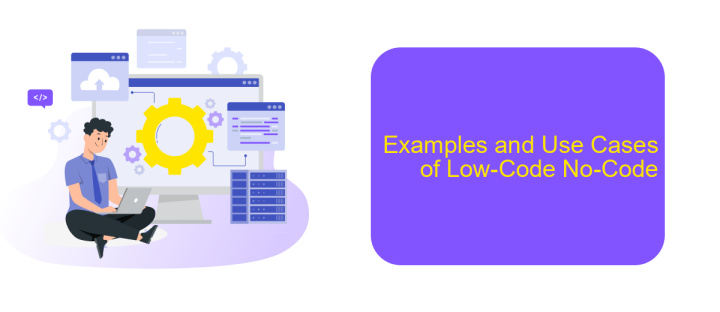What Does Low-Code No-Code Mean
Low-Code/No-Code platforms are revolutionizing the way applications are developed by allowing users to create software with minimal or no coding knowledge. These tools empower businesses to accelerate their digital transformation, reduce development costs, and improve agility. By enabling non-technical users to participate in the development process, Low-Code/No-Code solutions democratize innovation and foster a culture of collaboration.
Definition of Low-Code No-Code
Low-code and no-code platforms are revolutionizing the way applications are developed by enabling users to create software with minimal hand-coding. These platforms provide visual interfaces with drag-and-drop components, making it easier for non-developers to build and customize applications.
- Low-code: Requires some coding knowledge but significantly reduces the amount of manual coding needed. Suitable for developers aiming to speed up the development process.
- No-code: Designed for users with no coding experience. These platforms offer pre-built templates and components for easy application creation.
Both types of platforms are designed to streamline the development process, allowing businesses to quickly adapt to changing needs. Tools like ApiX-Drive can further enhance these platforms by providing seamless integration capabilities, enabling users to connect various applications and automate workflows without any coding. This democratization of software development empowers more people to bring their ideas to life efficiently.
Benefits of Low-Code No-Code

Low-code and no-code platforms offer numerous benefits, making them increasingly popular among businesses of all sizes. One significant advantage is the acceleration of development processes. These platforms enable users to build applications quickly without extensive coding knowledge, reducing the time-to-market for new solutions. This rapid development capability allows companies to respond more swiftly to changing market demands and stay competitive.
Another key benefit is the democratization of app development. Low-code and no-code platforms empower non-technical staff to create and deploy applications, fostering innovation across departments. Additionally, these platforms often come with built-in integration tools, such as ApiX-Drive, which streamline the process of connecting various systems and services. This ease of integration ensures that all business processes are cohesive and efficient, ultimately enhancing overall productivity and reducing operational costs.
Challenges and Limitations of Low-Code No-Code

While low-code and no-code platforms offer numerous benefits, they are not without challenges and limitations. One primary concern is the potential for vendor lock-in, where users become dependent on a specific platform's features and architecture, making it difficult to switch providers or scale applications independently.
- Limited Customization: These platforms often provide pre-built templates and components, which may not meet all specific business requirements, limiting the extent of customization.
- Scalability Issues: As applications grow, low-code and no-code solutions may struggle to handle increased complexity and user load, requiring more robust traditional development methods.
- Security Risks: The use of third-party platforms can introduce vulnerabilities, as users have limited control over the security measures implemented by the provider.
- Integration Challenges: Integrating with existing systems and databases can be complex. Services like ApiX-Drive can help streamline these integrations but may add additional costs and dependencies.
In summary, while low-code and no-code platforms can accelerate development and democratize application creation, they come with trade-offs that businesses must carefully consider. Ensuring that these platforms align with long-term goals and addressing their limitations is crucial for sustained success.
Examples and Use Cases of Low-Code No-Code

Low-code and no-code platforms have revolutionized the way businesses approach software development. By enabling users to create applications with minimal coding knowledge, these platforms have democratized the development process, making it accessible to a wider audience.
One of the most common use cases for low-code and no-code solutions is in the creation of internal business tools. Companies can quickly develop custom applications for project management, customer relationship management (CRM), and data analytics without the need for extensive programming skills.
- Automating workflows and business processes
- Developing mobile and web applications
- Integrating various software and services
- Creating dashboards and reports
For instance, ApiX-Drive is a service that allows businesses to set up integrations between different software applications effortlessly. By using a no-code approach, ApiX-Drive enables users to automate data transfer and synchronize information across platforms, thereby enhancing operational efficiency without requiring in-depth technical expertise.
Future of Low-Code No-Code
The future of low-code/no-code platforms is poised for significant growth and innovation. As businesses continue to seek faster and more efficient ways to develop applications, these platforms will become increasingly integral. They empower non-technical users to create and deploy applications with minimal coding knowledge, bridging the gap between business needs and IT capabilities. This democratization of app development not only accelerates project timelines but also reduces costs, making it an attractive option for organizations of all sizes.
Moreover, advancements in artificial intelligence and machine learning will further enhance the capabilities of low-code/no-code platforms. Tools like ApiX-Drive, which facilitate seamless integrations between various services, will become even more essential. ApiX-Drive allows users to automate workflows and connect different applications effortlessly, improving overall efficiency and productivity. As these technologies evolve, we can expect a surge in their adoption, leading to more innovative and agile business solutions. The future of low-code/no-code is undoubtedly bright, promising a more accessible and dynamic landscape for digital transformation.
FAQ
What does Low-Code/No-Code mean?
Who can benefit from Low-Code/No-Code platforms?
What are some common uses for Low-Code/No-Code platforms?
Are Low-Code/No-Code platforms secure?
Can Low-Code/No-Code platforms handle complex integrations?
Routine tasks take a lot of time from employees? Do they burn out, do not have enough working day for the main duties and important things? Do you understand that the only way out of this situation in modern realities is automation? Try Apix-Drive for free and make sure that the online connector in 5 minutes of setting up integration will remove a significant part of the routine from your life and free up time for you and your employees.

